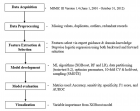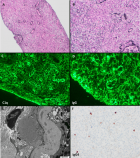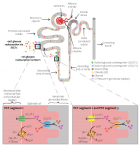Abstract
Research Article
Modeling the Risk of Liver Cancer in Adults: A Machine Learning Investigation into the Role of Obesity and Overweight
Karamo Bah*, Adama Ns Bah and Amadou Wurry Jallow
Published: 28 December, 2023 | Volume 7 - Issue 1 | Pages: 034-045
Background: Liver cancer is a global health concern, with overweight and obese individuals exhibiting an increased risk of its development. Understanding the interplay between obesity-related factors and liver cancer incidence is crucial for early prediction and intervention.
Aim: The aim of this investigation was to construct and validate an extreme gradient boosting (XGBoost) based machine learning model for the purpose of establishing a one-year liver cancer risk prediction system specifically tailored to overweight and obese patients. In addition, this study sought to compare the predictive performance of the XGBoost model with those of a random forest model and a logistic regression model, while also identifying the most influential predictive features for liver cancer incidence.
Methods: A comprehensive retrospective analysis was conducted on MIMIC III data comprising 2,354 patients. To predict the risk of liver cancer development, three machine learning models were developed: XGBoost, random forest, and logistic regression. Feature selection was executed using a stepwise regression procedure encompassing both forward selection and backward elimination.
Results: The stepwise regression technique unveiled 14 predictive factors for liver cancer incidence. Among the patient cohort, 132 individuals developed liver cancer within a year of follow-up, while 2,222 did not. Notably, most liver cancer cases occurred in male patients (60%). Statistically significant differences were observed between patients with liver cancer and those without, in terms of age, gender, total bilirubin, platelet, albumin, chloride, potassium, sodium, prothrombin time (PT) and alanine aminotransferase (ALT). The XGBoost model exhibited an impressive area under the receiver operating characteristic curve (AUROC) of 99%, Random Forest (RF) of 99%, and Logistic Regression (LR) of 90%. In a multivariate analysis, total bilirubin, creatinine levels, age, gender, ALT, alkaline phosphate (ALP), PT, calcium, and chloride emerged as independent predictors for liver cancer incidence.
Conclusion: The XGBoost model demonstrated superior predictive performance when compared to the RF and LR models. If corroborated through prospective studies, the XGBoost model may prove to be a valuable tool for the early prediction of liver cancer risk in overweight or obese individuals. Such predictive capabilities could, in turn, facilitate the implementation of timely preventive interventions against liver cancer.
Read Full Article HTML DOI: 10.29328/journal.apcr.1001039 Cite this Article Read Full Article PDF
Keywords:
Liver cancer; Obesity; Overweight; Machine learning; Risk prediction
References
- Lin L, Li Z, Yan L, Liu Y, Yang H, Li H. Global, regional, and national cancer incidence and death for 29 cancer groups in 2019 and trends analysis of the global cancer burden, 1990-2019. J Hematol Oncol. 2021 Nov 22;14(1):197. doi: 10.1186/s13045-021-01213-z. PMID: 34809683; PMCID: PMC8607714.
- Bosch FX, Ribes J, Díaz M, Cléries R. Primary liver cancer: worldwide incidence and trends. Gastroenterology. 2004 Nov;127(5 Suppl 1):S5-S16. doi: 10.1053/j.gastro.2004.09.011. PMID: 15508102.
- Perz JF, Armstrong GL, Farrington LA, Hutin YJ, Bell BP. The contributions of hepatitis B virus and hepatitis C virus infections to cirrhosis and primary liver cancer worldwide. J Hepatol. 2006 Oct;45(4):529-38. doi: 10.1016/j.jhep.2006.05.013. Epub 2006 Jun 23. PMID: 16879891.
- Saitta C, Pollicino T, Raimondo G. Obesity and liver cancer. Ann Hepatol. 2019 Nov-Dec;18(6):810-815. doi: 10.1016/j.aohep.2019.07.004. Epub 2019 Aug 20. PMID: 31543467.
- Spinelli A, Buoncristiano M, Nardone P, Starc G, Hejgaard T, Júlíusson PB, Fismen AS, Weghuber D, Musić Milanović S, García-Solano M, Rutter H, Rakovac I, Cucu A, Brinduse LA, Rito AI, Kovacs VA, Heinen MM, Nurk E, et al. Thinness, overweight, and obesity in 6- to 9-year-old children from 36 countries: The World Health Organization European Childhood Obesity Surveillance Initiative-COSI 2015-2017. Obes Rev. 2021 Nov;22 Suppl 6:e13214. doi: 10.1111/obr.13214. Epub 2021 Jul 7. PMID: 34235850.
- Kew MC. Hepatocellular carcinoma: epidemiology and risk factors. J Hepatocell Carcinoma. 2014 Aug 13;1:115-25. doi: 10.2147/JHC.S44381. PMID: 27508181; PMCID: PMC4918271.
- Larsson SC, Wolk A. Overweight, obesity and risk of liver cancer: a meta-analysis of cohort studies. Br J Cancer. 2007 Oct 8;97(7):1005-8. doi: 10.1038/sj.bjc.6603932. Epub 2007 Aug 14. PMID: 17700568; PMCID: PMC2360408.
- Sohn W, Lee HW, Lee S, Lim JH, Lee MW, Park CH, Yoon SK. Obesity and the risk of primary liver cancer: A systematic review and meta-analysis. Clin Mol Hepatol. 2021 Jan;27(1):157-174. doi: 10.3350/cmh.2020.0176. Epub 2020 Nov 26. PMID: 33238333; PMCID: PMC7820201.
- Renehan AG, Tyson M, Egger M, Heller RF, Zwahlen M. Body-mass index and incidence of cancer: a systematic review and meta-analysis of prospective observational studies. Lancet. 2008 Feb 16;371(9612):569-78. doi: 10.1016/S0140-6736(08)60269-X. PMID: 18280327.
- Saunders D, Seidel D, Allison M, Lyratzopoulos G. Systematic review: the association between obesity and hepatocellular carcinoma - epidemiological evidence. Aliment Pharmacol Ther. 2010 May;31(10):1051-63. doi: 10.1111/j.1365-2036.2010.04271.x. Epub 2010 Feb 18. PMID: 20175765.
- Johnson AE, Pollard TJ, Shen L, Lehman LW, Feng M, Ghassemi M, Moody B, Szolovits P, Celi LA, Mark RG. MIMIC-III, a freely accessible critical care database. Sci Data. 2016 May 24;3:160035. doi: 10.1038/sdata.2016.35. PMID: 27219127; PMCID: PMC4878278.
- Pigott TD. Handling missing data. The handbook of research synthesis and meta-analysis. 2009. 2: 399-416.
- Ramli MN. Roles of imputation methods for filling the missing values: A review. Advances in Environmental Biology. 2013; 7(12 S2): 3861-3870.
- Arunajadai SG. Stepwise logistic regression. Anesth Analg. 2009 Jul;109(1):285; author reply 285-6. doi: 10.1213/ane.0b013e3181a7b51a. PMID: 19535724.
- Portet S. A primer on model selection using the Akaike Information Criterion. Infect Dis Model. 2020 Jan 7;5:111-128. doi: 10.1016/j.idm.2019.12.010. PMID: 31956740; PMCID: PMC6962709.
- Chen T. Xgboost: extreme gradient boosting. R package version 0.4-2, 2015; 1(4): 1-4.
- Qi Y. Random forest for bioinformatics. Ensemble machine learning: Methods and applications. 2012: 307-323.
- Breiman L. Random forests. Machine Learning. 2001; 45: 5-32.
- Hosmer DW, Lemeshow S, Sturdivant RX. Applied logistic regression. John Wiley & Sons. 2013; 38.
- Sagi O, Rokach L. Approximating XGBoost with an interpretable decision tree. Information Sciences. 2021; 572: 522-542.
- Jakkula V. Tutorial on support vector machine (svm). School of EECS, Washington State University, 2006; 37(2.5): 3.
- Yuwen P, Chen W, Lv H, Feng C, Li Y, Zhang T, Hu P, Guo J, Tian Y, Liu L, Sun J, Zhang Y. Albumin and surgical site infection risk in orthopaedics: a meta-analysis. BMC Surg. 2017 Jan 16;17(1):7. doi: 10.1186/s12893-016-0186-6. PMID: 28093079; PMCID: PMC5238522.
- Deng S. A gradient boosting decision tree approach for insider trading identification: An empirical model evaluation of China stock market. Applied Soft Computing. 2019; 83: 105652.
- Cutler DR, Edwards TC Jr, Beard KH, Cutler A, Hess KT, Gibson J, Lawler JJ. Random forests for classification in ecology. Ecology. 2007 Nov;88(11):2783-92. doi: 10.1890/07-0539.1. PMID: 18051647.
- Titapiccolo JI. Artificial intelligence models to stratify cardiovascular risk in incident hemodialysis patients. Expert systems with applications. 2013; 40(11): 4679-4686.
- Oommen T, Baise LG, Vogel RM. Sampling bias and class imbalance in maximum-likelihood logistic regression. Mathematical Geosciences. 2011; 43: 99-120.
- Boateng EY, Abaye DA. A review of the logistic regression model with emphasis on medical research. Journal of data analysis and information processing. 2019; 7(4): 190-207.
- Shelke MS, Deshmukh PR, Shandilya VK. A review on imbalanced data handling using undersampling and oversampling technique. Int J Recent Trends Eng Res. 2017; 3(4): 444-449.
- Cohen G, Hilario M, Sax H, Hugonnet S, Geissbuhler A. Learning from imbalanced data in surveillance of nosocomial infection. Artif Intell Med. 2006 May;37(1):7-18. doi: 10.1016/j.artmed.2005.03.002. Epub 2005 Oct 17. PMID: 16233974.
- Chawla NV. SMOTE: synthetic minority over-sampling technique. Journal of artificial intelligence research. 2002; 16: 321-357.
- Kim JH. Estimating classification error rate: Repeated cross-validation, repeated hold-out and bootstrap. Computational statistics & data analysis. 2009; 53(11): 3735-3745.
- Berrar D. Cross-Validation. 2019.
- Probst P, Bischl B, Boulesteix AL. Tunability: Importance of hyperparameters of machine learning algorithms. arXiv preprint arXiv:1802.09596, 2018.
- Grislain N, Gonzalvez J. Dp-xgboost: Private machine learning at scale. arXiv preprint arXiv:2110.12770, 2021.
- Qiaona Q. Research progress on machine learning XGBoost algorithm in medicine. Journal of Molecular Imaging. 2021; 44(5): 856-862.
- Le PH, Kuo CJ, Hsieh YC, Chen TH, Lin CL, Yeh CT, Liang KH. Ages of hepatocellular carcinoma occurrence and life expectancy are associated with a UGT2B28 genomic variation. BMC Cancer. 2019 Dec 5;19(1):1190. doi: 10.1186/s12885-019-6409-3. PMID: 31805979; PMCID: PMC6896495.
- Yoo JJ, Lee J, Choi GH, Lee MW, Park DA. A nationwide study on the current treatment status and natural prognosis of hepatocellular carcinoma in elderly. Sci Rep. 2023 Sep 4;13(1):14584. doi: 10.1038/s41598-023-41771-5. PMID: 37666940; PMCID: PMC10477316.
- Yoon JS, Lee HA, Kim HY, Sinn DH, Lee DH, Hong SK, Cho JY, Choi J, Chang Y, Kong HJ, Kim E, Won YJ, Lee JH. Hepatocellular Carcinoma in Korea: an Analysis of the 2015 Korean Nationwide Cancer Registry. J Liver Cancer. 2021 Mar;21(1):58-68. doi: 10.17998/jlc.21.1.58. Epub 2021 Mar 31. Retracted and republished in: J Liver Cancer. 2022 Sep;22(2):207. PMID: 37384267; PMCID: PMC10035724.
- Tohme S, Bou Samra P, Kaltenmeier C, Chidi AP, Varley PR, Tsung A. Radioembolization for Hepatocellular Carcinoma: A Nationwide 10-Year Experience. J Vasc Interv Radiol. 2018 Jul;29(7):912-919.e2. doi: 10.1016/j.jvir.2018.03.018. Epub 2018 May 26. PMID: 29843996.
- Li Q, Cao M, Lei L, Yang F, Li H, Yan X, He S, Zhang S, Teng Y, Xia C, Chen W. Burden of liver cancer: From epidemiology to prevention. Chin J Cancer Res. 2022 Dec 30;34(6):554-566. doi: 10.21147/j.issn.1000-9604.2022.06.02. PMID: 36714347; PMCID: PMC9829497.
- Keng VW, Largaespada DA, Villanueva A. Why men are at higher risk for hepatocellular carcinoma? J Hepatol. 2012 Aug;57(2):453-4. doi: 10.1016/j.jhep.2012.03.004. Epub 2012 Mar 13. PMID: 22425699; PMCID: PMC3506003.
- Wu EM, Wong LL, Hernandez BY, Ji JF, Jia W, Kwee SA, Kalathil S. Gender differences in hepatocellular cancer: disparities in nonalcoholic fatty liver disease/steatohepatitis and liver transplantation. Hepatoma Res. 2018;4:66. doi: 10.20517/2394-5079.2018.87. Epub 2018 Oct 18. PMID: 30687780; PMCID: PMC6347119.
- Fu S, Wu D, Jiang W, Li J, Long J, Jia C, Zhou T. Molecular Biomarkers in Drug-Induced Liver Injury: Challenges and Future Perspectives. Front Pharmacol. 2020 Jan 30;10:1667. doi: 10.3389/fphar.2019.01667. PMID: 32082163; PMCID: PMC7002317.
- Fevery J. Bilirubin in clinical practice: a review. Liver Int. 2008 May;28(5):592-605. doi: 10.1111/j.1478-3231.2008.01716.x. PMID: 18433389.
- Zermatten MG, Fraga M, Calderara DB, Aliotta A, Moradpour D, Alberio L. Biomarkers of liver dysfunction correlate with a prothrombotic and not with a prohaemorrhagic profile in patients with cirrhosis. JHEP Rep. 2020 May 11;2(4):100120. doi: 10.1016/j.jhepr.2020.100120. PMID: 32715285; PMCID: PMC7369360.
- Kalas MA, Chavez L, Leon M, Taweesedt PT, Surani S. Abnormal liver enzymes: A review for clinicians. World J Hepatol. 2021 Nov 27;13(11):1688-1698. doi: 10.4254/wjh.v13.i11.1688. PMID: 34904038; PMCID: PMC8637680.
- Yin J, Yin LY, Freedman ND, Li TY, Dawsey SM, Cui JF, Taylor PR, Liu B, Fan JH, Chen W, Abnet CC, Qiao YL. Independent and Joint Associations between Serum Calcium, 25-Hydroxy Vitamin D, and the Risk of Primary Liver Cancer: A Prospective Nested Case-Control Study. Cancer Epidemiol Biomarkers Prev. 2020 Oct;29(10):2057-2064. doi: 10.1158/1055-9965.EPI-20-0417. Epub 2020 Aug 20. PMID: 32856608; PMCID: PMC8594771.
- Ashcroft RE. The declaration of Helsinki. The Oxford textbook of clinical research ethics. 2008; 141-148.
Figures:

Figure 1

Figure 2

Figure 3

Figure 4
Similar Articles
-
Modeling the Risk of Liver Cancer in Adults: A Machine Learning Investigation into the Role of Obesity and OverweightKaramo Bah*, Adama Ns Bah, Amadou Wurry Jallow. Modeling the Risk of Liver Cancer in Adults: A Machine Learning Investigation into the Role of Obesity and Overweight. . 2023 doi: 10.29328/journal.apcr.1001039; 7: 034-045
Recently Viewed
-
Non-surgical Treatment of Verrucous Hyperplasia on Amputation Stump: A Case Report and Literature ReviewSajeda Alnabelsi*, Reem Hasan, Hussein Abdallah, Suzan Qattini. Non-surgical Treatment of Verrucous Hyperplasia on Amputation Stump: A Case Report and Literature Review. Ann Dermatol Res. 2024: doi: 10.29328/journal.adr.1001034; 8: 015-017
-
Outpatient operative hysteroscopy: evaluation of patient satisfaction and acceptanceClare Margaret Crowley*,Noelle Gill,Minna Geisler. Outpatient operative hysteroscopy: evaluation of patient satisfaction and acceptance. Clin J Obstet Gynecol. 2022: doi: 10.29328/journal.cjog.1001098; 5: 005-008
-
Predictors of positive treatment response to PTNS in women with overactive bladderSuneetha Rachaneni*,Doyo Enki,Megan Welstand,Thomasin Heggie,Anupreet Dua. Predictors of positive treatment response to PTNS in women with overactive bladder. Clin J Obstet Gynecol. 2022: doi: 10.29328/journal.cjog.1001097; 5: 001-004
-
Prediction of neonatal and maternal index based on development and population indicators: a global ecological studySedigheh Abdollahpour,Hamid Heidarian Miri,Talat Khadivzadeh*. Prediction of neonatal and maternal index based on development and population indicators: a global ecological study. Clin J Obstet Gynecol. 2021: doi: 10.29328/journal.cjog.1001096; 4: 101-105
-
A Genetic study in assisted reproduction and the risk of congenital anomaliesKaparelioti Chrysoula,Koniari Eleni*,Efthymiou Vasiliki,Loutradis Dimitrios,Chrousos George,Fryssira Eleni. A Genetic study in assisted reproduction and the risk of congenital anomalies. Clin J Obstet Gynecol. 2021: doi: 10.29328/journal.cjog.1001095; 4: 096-100
Most Viewed
-
Evaluation of Biostimulants Based on Recovered Protein Hydrolysates from Animal By-products as Plant Growth EnhancersH Pérez-Aguilar*, M Lacruz-Asaro, F Arán-Ais. Evaluation of Biostimulants Based on Recovered Protein Hydrolysates from Animal By-products as Plant Growth Enhancers. J Plant Sci Phytopathol. 2023 doi: 10.29328/journal.jpsp.1001104; 7: 042-047
-
Sinonasal Myxoma Extending into the Orbit in a 4-Year Old: A Case PresentationJulian A Purrinos*, Ramzi Younis. Sinonasal Myxoma Extending into the Orbit in a 4-Year Old: A Case Presentation. Arch Case Rep. 2024 doi: 10.29328/journal.acr.1001099; 8: 075-077
-
Feasibility study of magnetic sensing for detecting single-neuron action potentialsDenis Tonini,Kai Wu,Renata Saha,Jian-Ping Wang*. Feasibility study of magnetic sensing for detecting single-neuron action potentials. Ann Biomed Sci Eng. 2022 doi: 10.29328/journal.abse.1001018; 6: 019-029
-
Pediatric Dysgerminoma: Unveiling a Rare Ovarian TumorFaten Limaiem*, Khalil Saffar, Ahmed Halouani. Pediatric Dysgerminoma: Unveiling a Rare Ovarian Tumor. Arch Case Rep. 2024 doi: 10.29328/journal.acr.1001087; 8: 010-013
-
Physical activity can change the physiological and psychological circumstances during COVID-19 pandemic: A narrative reviewKhashayar Maroufi*. Physical activity can change the physiological and psychological circumstances during COVID-19 pandemic: A narrative review. J Sports Med Ther. 2021 doi: 10.29328/journal.jsmt.1001051; 6: 001-007

HSPI: We're glad you're here. Please click "create a new Query" if you are a new visitor to our website and need further information from us.
If you are already a member of our network and need to keep track of any developments regarding a question you have already submitted, click "take me to my Query."















































































































































